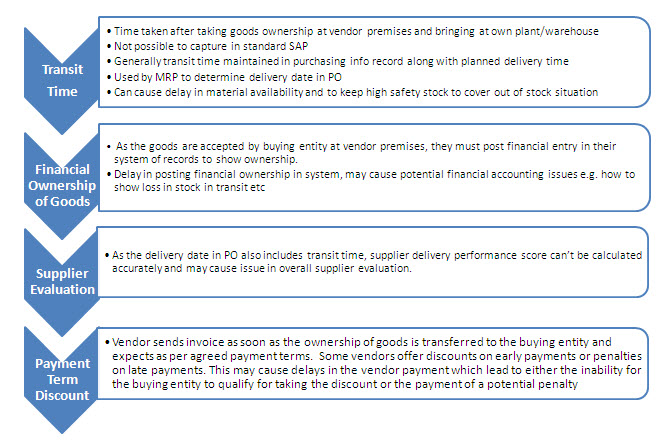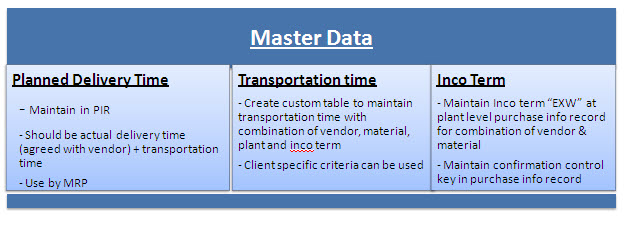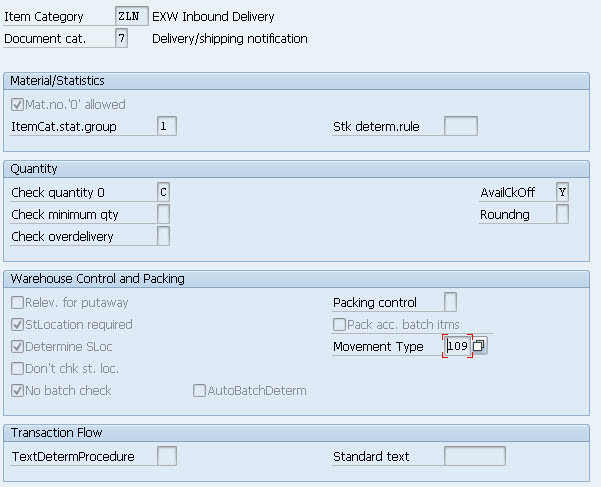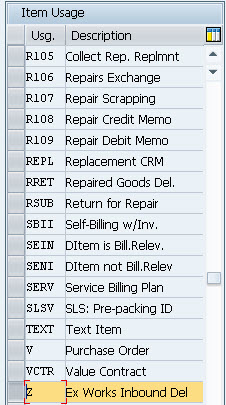Procurement with Origin Acceptance
In import procurement, the buyer or purchasing organization typically negotiates with a vendor to accept goods or to take ownership of goods at the vendor premises. In other words, the buying entity takes the financial ownership of the goods at the vendor premises and is therefore liable to pay the vendor even though the goods have not yet physically arrived at the buyer’s location (plant/warehouse). In international commerce trading terminology it is called EX-Works procurement and recognized by the International Commercial Term (Incoterm) “EXW”.
Standard SAP provides the capability to use the Incoterm “EXW” in the purchasing documents such as purchase orders, contracts and/or scheduling agreements. Though SAP also has an inventory movement type (107) which can accept goods at the origin, the standard SAP solution doesn’t have end to end integration to use the Incoterm “EXW’, origin acceptance along with movement type 107. The lack of integration of the origin of acceptance functionality with the follow-on business processes (goods receipts, invoice postings and releases, vendor payments, MRP functionality and so on) requires some manual intervention at each business process step starting with the PO creation up to the invoice processing in order to use it efficiently. Manual intervention in the business process can potentially impact the following areas:
| Account Payable/Finance | Procurement | Material Requirement Planning |
| -Delay vendor payment
– In-transit stock ownership and financial posting in SAP system |
-Uncertainty of delivery date/ownership from vendor
– Supplier performance evaluation |
– Stock availability for use
– Over or under planning by MRP |
The purpose of this document is to describe how to design and build the end to end procurement process for “origin at acceptance functionality” within SAP with additional configuration as well as custom development work which will allow for the avoidance of any manual intervention.
Below is the expected high level procurement business process flow regarding the concept of origin at acceptance:
Process Flow- Procurement by Origin Acceptance
GAPs in Standard SAP
When above described process mapped within standard SAP, following gaps occurs.
How to Fix these GAPS
All of the above referenced gaps can be addressed with the below listed work: additional master data setup, configuration and custom development in SAP ECC. This can make procurement with origin of acceptance a seamless process avoiding any manual interventions.
Master Data Setting:
Configuration
Perform below configuration activities to determine Movement Type 109 in IBD
1. Configure new item category for inbound delivery: Create new item category e.g. ZEL for inbound delivery and assign movement 109 for this item category.
IMG Path: SPRO->Logistics Execution->Deliveries-> Define Item Categories for Deliveries
2. Define Item Category Usage: Define new item category usage
IMG Path: SPRO->Logistics Execution->Deliveries-> Define Item Category Usage)
3. Define Item category determinations in Deliveries: Define new item category determination (defined in step) during inbound delivery creation for combination of item categories.
Repeat this step for all item categories defined in material master.
Custom Development
1. Development to determine “Origin of Acceptance” in PO automatically
To default origin of acceptance indicator in purchase order, implement BADI ME_PROCESS_PO_CUST and class PROCESS_ITEM.In the BADI write logic to check incoterm at PO line item level and if it is “EXW”, set origin of acceptance indicator in PO (you can use other logic as well to set origin of acceptance indicator).
2. Create Custom Table to Maintain Transportation Time:
Create custom table to maintain transportation time for the combination of vendor, material, plant and incoterm. (Client may use other criteria based on business requirement). Include this table maintenance in one of the support role.
3. Delivery Date in Purchasing Form Output:
Modify Purchase order form output to read delivery date as below for procurement with origin acceptance scenario only.
If Inco term at PO line item level is “EXW” then
PO Delivery date for line item = PO Delivery Date (EKPO- EEIND) – Transportation Time from custom tabbased on vendor/material/plant/incoterm combination.
4. Delivery Date in Purchasing Output by EDI: (Optional)
This development is required only if procurement with origin acceptance is done with EDI vendor. In this case, identify enhancement spot in outbound PO message type ORDERS05 and apply same logic as mentioned in step 3.
5. Delivery Date in ASN or order confirmation by EDI: (Optional)
This development is required only if procurement with origin acceptance is done with EDI vendor and vendor sends and vendor send order confirmation and advance shipping notification by EDI. In this case, identify enhancement spot in inbound PO confirmation (Message type ORDRSP) and advance shipping notification (DESADV) and apply below logic.
Delivery date in order confirmation or ASN= Delivery date provided by vendor + Transportation Time from custom table based on vendor/material/plant/incotem combination
Delivery date from order confirmation or ASN is used by MRP for planning purpose.
6. Development to determine Movement Type 109 in IBD
Implement enhancement spot ES_SAPMV50A and object MM_INB_DEL_ITEM_CATEGORY and write logic to determine item category “ZEL” in IBD (inbound delivery) for origin of acceptance scenario. In the logic, check inco term at PO line item level (EKPO-INCO1), if it is “EXW” then select item category from table T184L for delivery type is “EL” and usage “Z” and update in the field “XLIPS-PSTYV” (item category in inbound delivery).
7. Supplier Evaluation:
Update your supplier evaluation program to calculate delivery score for procurement with origin acceptance as below (Generally Supplier evaluation program is customer specific therefore program details not provided)
If PO line item has inco term “EXW”, then target delivery date as
Target delivery date= Delivery date from PO (EKPO-EEIND) – Transportation Time from custom table based on vendor/material/plant/incoterm combination
Actual Delivery Date= EKEB-BUDAT (Delivery date with ref to PO posted by movement type 107) by using PO# and where EKBE- BWART= 107
Compare target delivery date actual delivery date and assign delivery score appropriately.
8. Update security profile
To allow buyer to post good receipt for procurement with origin at acceptance by using TCode MIGO and movement type 107.
Value Addition/Benefit and Impact
Ø Seamless end to end integrated process without manual intervention
Ø Actual delivery date communicated to vendor and actual physical goods receipt date used by MRP
Ø Origin acceptances by movement type 107 have following impact on MM, FI and LIV.
|
FI Impact |
MM Impact |
LIV Impact |
| ü Accounting document generated | ü Origin acceptance date recorded
ü Item placed in valuated blocked stock ü Not available for use |
ü Invoice block removed
ü Invoice available for payment as per agreed term prior to taking physical control of the items |
Ø Actual good receipts by movement type 109 have following impact
|
FI Impact |
MM Impact |
LIV Impact |
| ü No financial documented posted | ü Physical goods receipt date recorded
ü Goods available for use |
ü No Impact |
Possible to monitor goods accepted at origin and current stock status by using report MB5OA







Leave A Comment?
You must be logged in to post a comment.